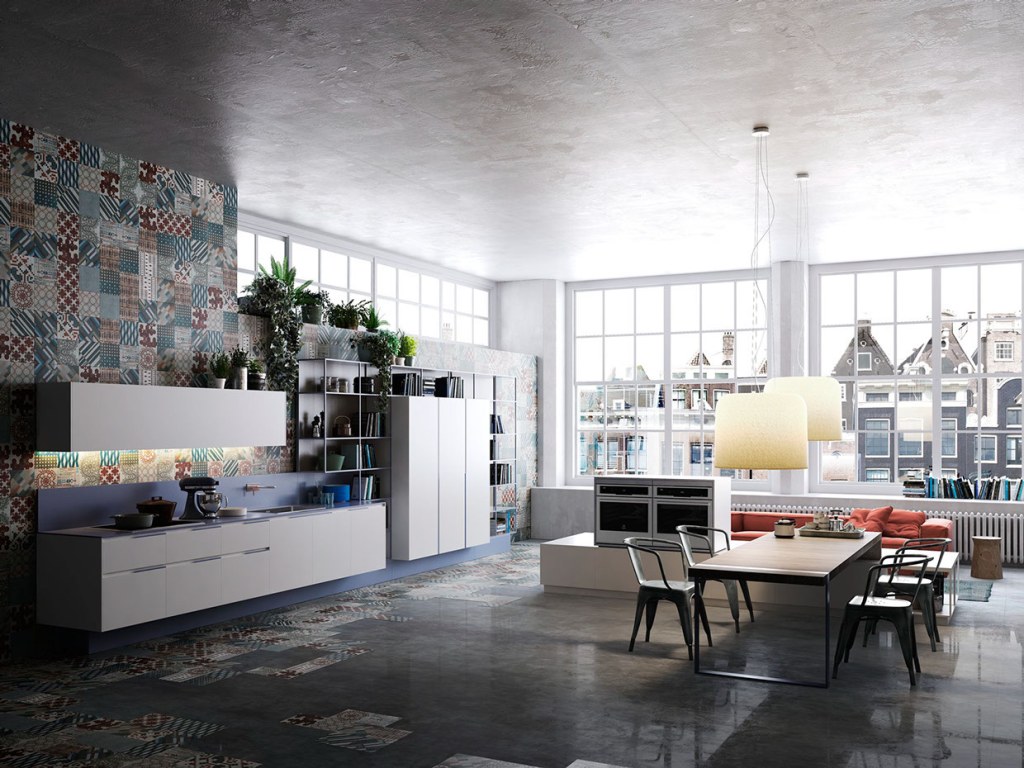Transform Your Space With Stunning Loft Interiors – Unleash Your Creativity Today!
Lorem Ipsum
Introduction
Welcome, Interior Enthusiast! In this article, we will dive into the fascinating world of loft interiors. Lofts offer a unique living experience, combining industrial aesthetics with modern comfort. Whether you are a Home Lover looking for inspiration or someone interested in the history and design of loft interiors, this article will provide you with a comprehensive overview. So, sit back, relax, and let’s explore the captivating world of loft interiors together!
3 Picture Gallery: Transform Your Space With Stunning Loft Interiors – Unleash Your Creativity Today!



Overview of Loft Interiors
Loft interiors have gained popularity over the years as an alternative living space that combines open layouts with exposed brick walls, high ceilings, and large windows. Originally, lofts were spaces converted from industrial buildings such as factories, warehouses, or mills. They were primarily used by artists and bohemians seeking affordable and spacious living areas. However, in recent years, loft living has become a mainstream trend, appealing to a broader audience.

Image Source: alamy.com
Today, loft interiors are not limited to converted industrial spaces but can also be found in newly constructed buildings designed with a loft-like aesthetic. The key features of loft interiors are the open floor plans, expansive windows, and the use of industrial materials such as concrete, metal, and exposed ductwork. This unique combination creates a modern and edgy atmosphere that is highly sought after in the world of interior design.
Now, let’s delve deeper into the different aspects of loft interiors, from their origins to the pros and cons of living in one.
What are Loft Interiors?

Image Source: decoholic.org
Loft interiors are living spaces characterized by open layouts, high ceilings, and industrial design elements. They are often located in converted industrial buildings or purpose-built structures that imitate the loft aesthetic. The absence of walls allows for a flexible and fluid living environment, providing ample space for creativity and personalization.
The design elements commonly found in loft interiors include exposed brick walls, concrete floors, metal beams, and large windows. These features contribute to the industrial charm and give the spaces a raw and authentic feel. Additionally, loft interiors often incorporate modern furniture and minimalist decor to create a harmonious balance between old and new.

Image Source: home-designing.com
Living in a loft interior offers a unique experience, providing a sense of openness and freedom that is not typically found in traditional homes. The absence of walls allows for natural light to flood the space, creating a bright and airy atmosphere. The high ceilings give a grandeur to the space and allow for the installation of lofted bedrooms or mezzanine levels.
While loft interiors have become more mainstream, they still retain their association with creativity and artistic expression. Many artists, designers, and entrepreneurs choose loft living as it provides an inspiring environment that encourages innovation and self-expression. However, loft interiors are not limited to these groups, and anyone can appreciate and enjoy the unique charm they offer.
Who Should Consider Loft Living?
Loft living appeals to a diverse range of individuals, each drawn to the unique qualities and benefits it provides. Here are a few groups of people who might consider loft living:
1. Artists and Creatives: Loft interiors have long been synonymous with artistic communities. The open layouts and abundant natural light make them ideal spaces for artists to work and showcase their creations.
2. Professionals: Loft interiors offer a stylish and modern living experience for young professionals who value the combination of convenience and aesthetics.
3. Empty Nesters: After children have moved out, empty nesters often seek downsizing options. Loft interiors provide a spacious and contemporary alternative to traditional homes.
4. Urban Dwellers: City dwellers who crave the hustle and bustle of urban life often find loft living appealing. The proximity to cultural hotspots and vibrant neighborhoods is a significant draw.
5. Design Enthusiasts: Home enthusiasts who appreciate unique aesthetics and architectural features often gravitate towards loft interiors, as they offer an opportunity to showcase their design sensibilities.
Whether you fall into one of these categories or simply have an appreciation for the industrial charm of loft interiors, living in a loft can be a rewarding and fulfilling experience.
When Did Loft Living Emerge?
The concept of loft living emerged in the mid-20th century when artists and bohemians started repurposing vacant industrial spaces as living areas. These spaces were initially used as affordable alternatives to traditional apartments, providing ample room for both living and working.
The trend gained momentum in the 1960s and 1970s when artists flocked to the rundown industrial neighborhoods of cities like New York and London. These areas offered affordable rents and large open spaces that were perfect for artists’ studios. Over time, the appeal of loft living extended beyond artists and began attracting a broader audience.
In recent years, the demand for loft interiors has grown exponentially. Real estate developers recognized the popularity of loft living and started constructing purpose-built loft buildings to meet the increasing demand. Today, loft living has become a symbol of urban luxury and a desirable lifestyle choice for many.
Where Can You Find Loft Interiors?
Loft interiors can be found in various locations, depending on the availability of converted industrial buildings or newly constructed loft-style developments. Here are some common places where you can find loft interiors:
1. Industrial Neighborhoods: Former industrial areas in cities often have a concentration of loft buildings. These neighborhoods have undergone gentrification, attracting residents seeking the unique charm of loft living.
2. Urban Centers: Cities with a vibrant cultural scene and a thriving arts community are more likely to have a significant number of loft interiors. These spaces often cater to the artistic crowd.
3. Converted Warehouses: Warehouses that were once used for storage or manufacturing purposes have been transformed into trendy loft buildings. These conversions retain the industrial character of the original buildings.
4. Purpose-Built Developments: In response to the growing demand for loft living, developers have constructed purpose-built loft buildings. These buildings imitate the loft aesthetic and offer modern amenities.
Whether you prefer the authenticity of a converted industrial space or the convenience of a purpose-built loft building, there are various options available to suit your preferences and location.
Why Choose Loft Interiors?
The allure of loft interiors lies in their unique combination of industrial aesthetics and modern comfort. Here are some reasons why you might consider choosing a loft interior:
1. Spaciousness: Loft interiors offer ample space for living, working, and entertaining. The absence of walls creates a flexible layout that allows for customization and adaptation to your lifestyle.
2. Natural Light: The large windows found in loft interiors allow for an abundance of natural light. This creates a bright and airy atmosphere, enhancing the overall ambiance of the space.
3. Industrial Charm: Loft interiors exude an industrial charm that is highly sought after in the world of interior design. The exposed brick walls, raw materials, and open ceilings create a unique aesthetic that adds character and personality to your living space.
4. Design Versatility: The open floor plans of loft interiors provide endless possibilities for design and decor. You can create distinct zones within the space, incorporating different styles and aesthetics to suit your taste.
5. City Living: Loft interiors are often located in vibrant urban neighborhoods, offering easy access to cultural attractions, restaurants, and entertainment. If you thrive in an urban environment, loft living provides the perfect blend of convenience and excitement.
While loft living may not be suitable for everyone, those who appreciate the unique qualities and advantages it offers will find it to be an exceptional living experience.
How to Design Your Loft Interior?
Designing your loft interior is an exciting process that allows you to showcase your personal style and preferences. Here are some tips to help you create a stunning loft space:
1. Embrace the Industrial Aesthetic: Highlight the industrial charm of your loft by preserving and accentuating its original features. Exposed brick walls, concrete floors, and metal beams are the foundation of the loft aesthetic.
2. Optimize Natural Light: Make the most of the large windows by choosing light-colored window treatments or leaving them bare to allow natural light to penetrate the space. This will enhance the openness and brightness of your loft.
3. Define Zones: Use furniture, rugs, or room dividers to create distinct zones within your loft. This will help define different areas for living, dining, working, or sleeping.
4. Incorporate Texture: Add texture to your loft interior by introducing elements such as cozy rugs, plush cushions, or textured wallpapers. This will bring warmth and visual interest to the space.
5. Choose Versatile Furniture: Opt for furniture that can serve multiple purposes to maximize the functionality of your loft. For example, consider a sofa that can also be used as a guest bed or a dining table that can double as a workspace.
Remember, designing your loft interior should be a reflection of your personal style and preferences. Let your creativity soar and create a space that is uniquely yours.
Advantages and Disadvantages of Loft Interiors
Like any living arrangement, loft interiors come with their own set of advantages and disadvantages. Here are some pros and cons to consider before deciding to live in a loft:
Advantages of Loft Interiors
1. Spaciousness: Loft interiors offer generous living areas and high ceilings, providing a sense of spaciousness that is hard to find in traditional homes.
2. Unique Aesthetics: The industrial design elements of loft interiors create a distinctive and visually appealing atmosphere that stands out from conventional interiors.
3. Flexibility: The absence of walls in loft interiors allows for flexible layouts and customization to suit your needs and preferences.
4. Natural Light: The large windows found in loft interiors bring in ample natural light, creating a bright and inviting living environment.
5. Creativity and Personalization: Loft interiors provide a blank canvas for creativity and self-expression. You have the freedom to design and decorate the space according to your unique style.
Disadvantages of Loft Interiors
1. Limited Privacy: The open floor plan of loft interiors means that privacy can be compromised, especially in terms of sound and visual barriers.
2. Heating and Cooling: The high ceilings and large windows in loft interiors can make temperature regulation challenging, leading to higher energy costs.
3. Noise: Loft interiors, especially those located in urban areas, may be subject to noise from neighboring units or the surrounding environment.
4. Maintenance: The industrial elements in loft interiors require regular maintenance and may be more prone to wear and tear compared to traditional homes.
5. Limited Storage: The open layout of loft interiors often means limited storage space. Creative solutions such as built-in shelving or storage furniture may be necessary.
FAQs About Loft Interiors
1. Can I transform any space into a loft interior?
While it is technically possible to convert various types of spaces into loft interiors, certain architectural features such as high ceilings and large windows are essential to achieve the desired loft aesthetic.
2. Are loft interiors only suitable for urban areas?
No, loft interiors can be found in various settings, including suburban areas. However, they are more commonly associated with urban environments due to their historical connection to industrial neighborhoods.
3. Are loft interiors suitable for families with children?
Loft interiors can accommodate families with children, but it is important to consider the open floor plan and limited privacy. Some families choose to incorporate room dividers or convert lofted areas into private spaces for children.
4. How can I create privacy in a loft interior?
Privacy in a loft interior can be enhanced through the use of room dividers, curtains, or furniture placement. Additionally, incorporating lofted bedrooms or mezzanine levels can create designated private spaces.
5. Can I incorporate traditional elements into my loft interior?
Absolutely! Loft interiors can be personalized to suit individual preferences. You can mix traditional elements with industrial design to create a unique and eclectic space.
Conclusion
After exploring the world of loft interiors, we hope you have gained a deeper understanding of their history, design elements, and advantages. Living in a loft offers a unique experience that combines industrial aesthetics with modern comfort. Whether you are an artist seeking an inspiring space or a design enthusiast captivated by the industrial charm, loft interiors provide a world of possibilities.
If you are considering loft living, take the time to envision how you would design and personalize your space. Embrace the open floor plan, optimize natural light, and let your creative spirit guide you. From converted warehouses to purpose-built loft buildings, there are various options available to suit your preferences and location.
Remember, loft living is not without its challenges. Limited privacy and temperature regulation are factors to consider. However, the advantages of spaciousness, unique aesthetics, and flexibility often outweigh the disadvantages.
So, if you are ready to embark on a journey of creativity and self-expression, consider making a loft interior your next home. Open your doors to the industrial charm, and create a living space that truly reflects your style and personality.
Final Remarks
Loft interiors have become a symbol of urban luxury and artistic expression. They provide a unique living experience that marries industrial design with modern comfort. However, it is crucial to consider the specific characteristics and challenges that come with living in a loft.
Before committing to loft living, ensure that you are comfortable with the open layout, limited privacy, and potential maintenance requirements. Additionally, carefully assess the
This post topic: Interiors


